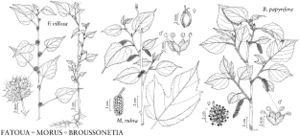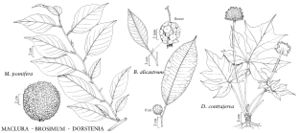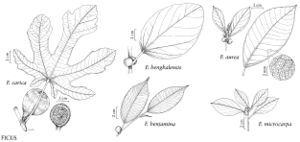Difference between revisions of "Moraceae"
FNA>Volume Importer |
imported>Volume Importer |
||
| (5 intermediate revisions by 2 users not shown) | |||
| Line 100: | Line 100: | ||
|family=Moraceae | |family=Moraceae | ||
|illustrator=John Myers | |illustrator=John Myers | ||
| + | |illustration copyright=Flora of North America Association | ||
|distribution=Widespread in tropical and subtropical regions;less common in temperate areas. | |distribution=Widespread in tropical and subtropical regions;less common in temperate areas. | ||
|reference=engler1888b;rohwer1993a;tomlinson1980a | |reference=engler1888b;rohwer1993a;tomlinson1980a | ||
| Line 105: | Line 106: | ||
|publication year= | |publication year= | ||
|special status= | |special status= | ||
| − | |source xml=https:// | + | |source xml=https://bitbucket.org/aafc-mbb/fna-data-curation/src/2e0870ddd59836b60bcf96646a41e87ea5a5943a/coarse_grained_fna_xml/V3/V3_430.xml |
}}<!-- | }}<!-- | ||
-->[[Category:Treatment]] | -->[[Category:Treatment]] | ||
Latest revision as of 21:48, 5 November 2020
Trees, shrubs, herbs, or vines, deciduous or evergreen, frequently with milky sap. Leaves alternate (rarely opposite or whorled), simple; stipules present, persistent or caducous; petiole adaxially grooved. Leaf blade: margins entire, toothed, or lobed; venation pinnate or with 3-5 basal palmate veins; cystoliths often present in epidermal cells. Inflorescences racemes, cymes, or capitula. Flowers unisexual, staminate and pistillate on same or different plants, small, occasionally on flattened torus, more often enclosed within fleshy, flask-shaped receptacle (syconium); sepals 2-6, distinct or partly connate (vestigial in Brosimum). Staminate flowers: stamens equal in number to sepals or calyx lobes and opposite them, straight or inflexed; anthers 1-2-locular. Pistillate flowers: sepals or calyx lobes 4, ± connate; pistils 1, 1-2-carpellate; ovary 1, superior or inferior, 1(-2)-locular; ovules 1 per locule; styles or style branches 1-2; stigmas 1-2, entire. Fruits multiple (syncarps); individual achenes or drupelets partly or completely enclosed by enlarged common receptacle or by individual calyces.
Distribution
Widespread in tropical and subtropical regions, less common in temperate areas.
Discussion
Genera ca. 40, species nearly 1100 (7 genera, 18 species in the flora).
Members of the large and diverse mulberry family are mainly woody and tropical; they are most abundant in Asia. The largest genera are Ficus, with approximately 750 species, and Dorstenia, with about 170 species. The family includes important timber trees, e.g., Chlorophora excelsa (Welwitsch) Bentham, iroko, from tropical Africa; Brosimum guianense (Aublet) Huber, letterwood, snakewood; and Ficus spp. Genera with species bearing edible fruits include the mulberries, Morus spp.; breadfruit and jackfruit, e.g., Artocarpus altilis (Parkinson) Fosberg and A. heterophyllus Lamarck; and figs, Ficus spp. Several species of Ficus are commonly cultivated in subtropical regions of the United States. These include F. carica Linnaeus; F. elastica Roxburgh ex Hornemann, India rubber plant; F. benghalensis Linnaeus, banyan; F. benjamina Linnaeus, weeping fig; F. pumila Linnaeus, creeping fig; and F. microcarpa Linnaeus f., Indian-laurel.
Rubber plants and weeping figs are commonly sold as houseplants. Economically, the most important species are those associated with the silk trade. Morus alba Linnaeus, M. indica Linnaeus, M. laevigata Wallis, and M. serrata Roxburgh, cultivated in many temperate and tropical countries, provide the natural food source for the silkworm, Bombyx mori Linnaeus.
Cudrania tricuspidata (Carrière) Bureau ex Lavallée, used as a food source for silkworms when Morus spp. are in short supply, is cultivated in North America as a hedge plant. The fruit is edible. Native to Korea and China, C. tricuspidata is known from a collection made in 1956 in McIntosh County, Georgia (S. B. Jones Jr. and N. C. Coile 1988), and it is naturalized in Orange County, North Carolina (R. D. Whetstone, pers. comm.).
Selected References
Illustrations
Key
| 1 | Herbs. | > 2 |
| 1 | Trees, shrubs, or vines. | > 3 |
| 2 | Plants lacking evident aerial stems, rhizomatous, perennial; inflorescences axillary, long-pedunculate. | Dorstenia |
| 2 | Plants caulescent, taprooted, annual; inflorescences axillary, short-pedunculate. | Fatoua |
| 3 | Flowers all borne on inside of syconium; terminal vegetative bud surrounded by pair of stipules. | Ficus |
| 3 | Flowers not borne on inside of syconium or only a solitary female flower immersed in receptacle; terminal vegetative bud scaly, not surrounded by pair of stipules. | > 4 |
| 4 | Margins of leaf blade toothed, often lobed; venation appearing palmate, or weakly 3-veined from base. | > 5 |
| 4 | Margins of leaf blade entire, never lobed; venation pinnate. | > 6 |
| 5 | Pistillate inflorescences globose; styles unbranched. | Broussonetia |
| 5 | Pistillate inflorescences cylindric; styles 2-branched. | Morus |
| 6 | Leaf blade ovate to lanceolate, not leathery; trees deciduous; syncarps 8-12 cm diam. | Maclura |
| 6 | Leaf blade oblong, leathery; trees evergreen; syncarps 1.5 cm diam. | Brosimum |


